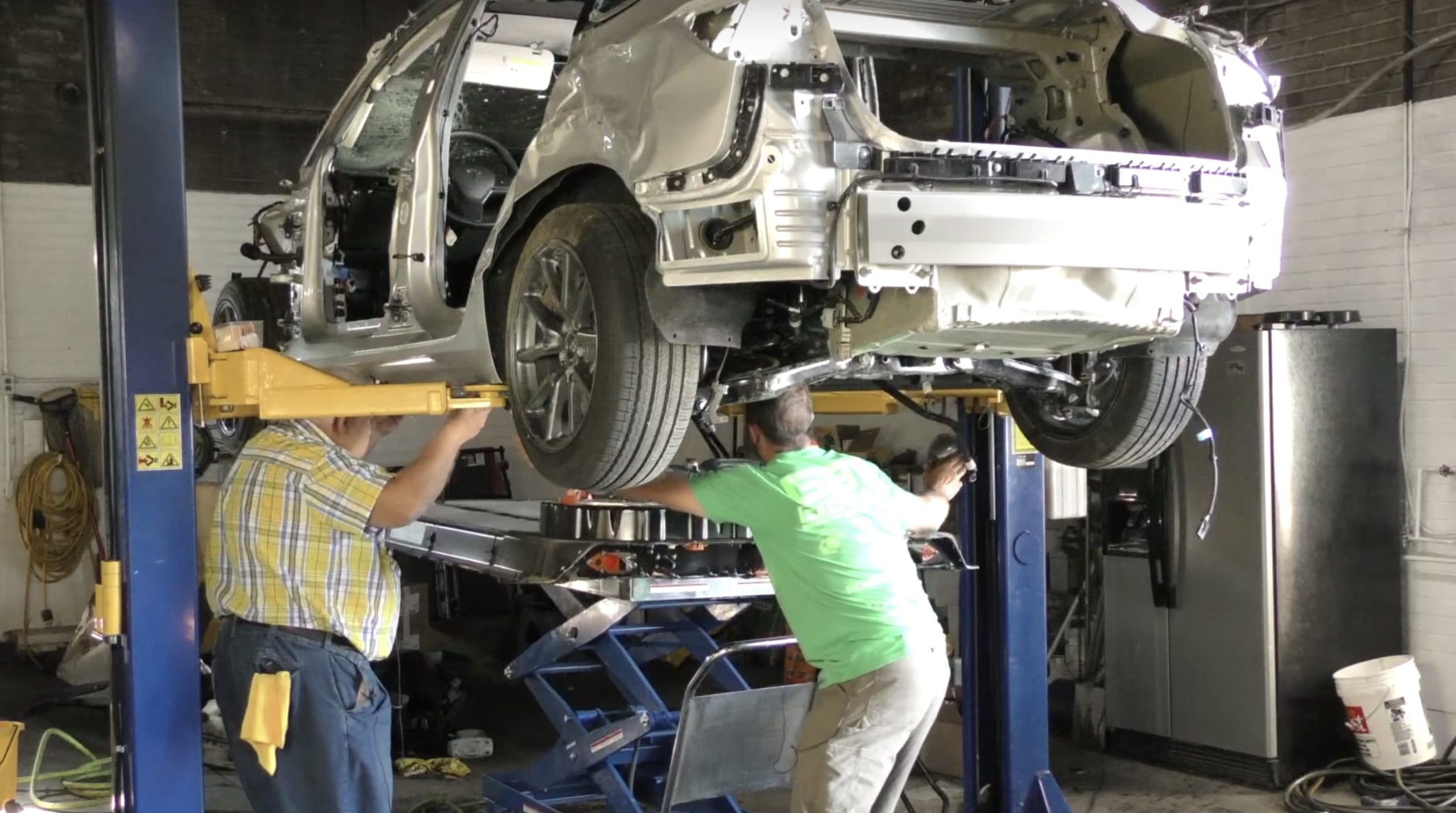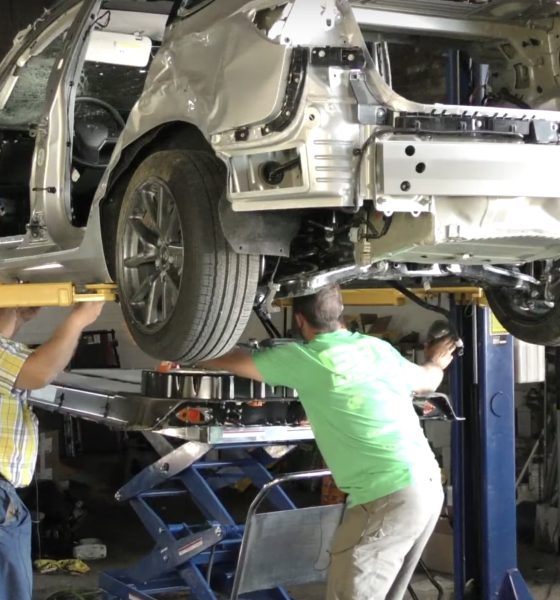

News
Tesla Model 3 battery details revealed in partial teardown and analysis
The Tesla Model 3’s battery pack was given a partial teardown treatment recently, thanks to the efforts of automotive veteran Jack Rickard and his team at EVTV. Rickard, a car enthusiast who conducts electric vehicle conversions, was ultimately impressed with how the Model 3’s battery was assembled, as well as the refinement of its design.
Rickard’s team was able to acquire the battery pack from a totaled Model 3. Upon removing the pack from the vehicle, the electric car conversion specialist’s interest was piqued by the covering of the battery modules. According to Rickard, the sections of the battery pack directly above the Model 3’s 2170 cells had a thin pad that was strangely wet.
This particular section mentioned by Rickard appear to be the “fluff” that Elon Musk mentioned during Tesla’s Q1 2018 earnings call. According to Musk, the fiberglass mats, which are placed on top of the battery pack, became one of the scenarios that proved human hands can work better than robots.
“They’re basically fluff. We tried to automate the placement and bonding of fluff to the top of the battery pack, which was ridiculous. ‘Flufferbot,’ which was really an incredibly difficult machine to make work. Machines are not good at picking up pieces of fluff. Hands are way better at doing that,” Musk said.
Another particularly compelling observation highlighted by Rickard was that the four modules of the Model 3 battery pack were not identical, with two modules featuring 25 cell groups in series and the other two featuring 23 cell groups in series. Rickard’s team did not tear down the battery packs down to its individual 2170 cells, but it was mentioned that each one of the cell groups includes 46 2170 cells that are connected in parallel. Overall, the vehicle appears to have a total of 4,416 2170 cells, at least for the Model 3’s long-range RWD configuration.
The Model 3’s battery weighs 1,054 pounds, which, according to the group, places the energy density of the pack at around 168 Wh/kg. The individual modules of the Model 3 battery are lined with a ribbon-like circuit that goes across the top of the modules and into a BMS board. The BMS boards are sub-boards that are installed on each module, and are, in turn, connected to a main board using only two pins.
Ultimately, the EVTV team was impressed with the Model 3’s battery, with Rickard even dubbing it as the “best battery ever built to date.” The electric car conversion specialist also noted that the Model 3 battery would likely be a favorite among the DIY community. Considering that Tesla is attempting to achieve a production rate of 5,000 Model 3 per week by the end of Q2 2018, Rickard noted that the electric car’s batteries would probably be abundant in the market. This bodes well for DIY enthusiasts like Rickard, who could utilize the modules as batteries for RVs, home battery units, and electric car conversions, among other projects.
Jack Rickard and his team’s observations about the Model 3’s battery are in line with the findings of Sandy Munro during his firm’s teardown of the vehicle. In a recent episode of Autoline After Hours, Munro dubbed the Model 3’s pack as the best in the industry, noting the .2 milliamp differential between each of the battery blocks.
“Nobody can balance batteries that close. Nobody. Nobody’s ever done that,” Munro said.
Watch Jack Rickard and his team’s Model 3 battery teardown in the video below.

Elon Musk
Elon Musk’s xAI brings 1GW Colossus 2 AI training cluster online
Elon Musk shared his update in a recent post on social media platform X.

xAI has brought its Colossus 2 supercomputer online, making it the first gigawatt-scale AI training cluster in the world, and it’s about to get even bigger in a few months.
Elon Musk shared his update in a recent post on social media platform X.
Colossus 2 goes live
The Colossus 2 supercomputer, together with its predecessor, Colossus 1, are used by xAI to primarily train and refine the company’s Grok large language model. In a post on X, Musk stated that Colossus 2 is already operational, making it the first gigawatt training cluster in the world.
But what’s even more remarkable is that it would be upgraded to 1.5 GW of power in April. Even in its current iteration, however, the Colossus 2 supercomputer already exceeds the peak demand of San Francisco.
Commentary from users of the social media platform highlighted the speed of execution behind the project. Colossus 1 went from site preparation to full operation in 122 days, while Colossus 2 went live by crossing the 1-GW barrier and is targeting a total capacity of roughly 2 GW. This far exceeds the speed of xAI’s primary rivals.
Funding fuels rapid expansion
xAI’s Colossus 2 launch follows xAI’s recently closed, upsized $20 billion Series E funding round, which exceeded its initial $15 billion target. The company said the capital will be used to accelerate infrastructure scaling and AI product development.
The round attracted a broad group of investors, including Valor Equity Partners, Stepstone Group, Fidelity Management & Research Company, Qatar Investment Authority, MGX, and Baron Capital Group. Strategic partners NVIDIA and Cisco also continued their support, helping xAI build what it describes as the world’s largest GPU clusters.
xAI said the funding will accelerate its infrastructure buildout, enable rapid deployment of AI products to billions of users, and support research tied to its mission of understanding the universe. The company noted that its Colossus 1 and 2 systems now represent more than one million H100 GPU equivalents, alongside recent releases including the Grok 4 series, Grok Voice, and Grok Imagine. Training is also already underway for its next flagship model, Grok 5.
Elon Musk
Tesla AI5 chip nears completion, Elon Musk teases 9-month development cadence
The Tesla CEO shared his recent insights in a post on social media platform X.

Tesla’s next-generation AI5 chip is nearly complete, and work on its successor is already underway, as per a recent update from Elon Musk.
The Tesla CEO shared his recent insights in a post on social media platform X.
Musk details AI chip roadmap
In his post, Elon Musk stated that Tesla’s AI5 chip design is “almost done,” while AI6 has already entered early development. Musk added that Tesla plans to continue iterating rapidly, with AI7, AI8, AI9, and future generations targeting a nine-month design cycle.
He also noted that Tesla’s in-house chips could become the highest-volume AI processors in the world. Musk framed his update as a recruiting message, encouraging engineers to join Tesla’s AI and chip development teams.
Tesla community member Herbert Ong highlighted the strategic importance of the timeline, noting that faster chip cycles enable quicker learning, faster iteration, and a compounding advantage in AI and autonomy that becomes increasingly difficult for competitors to close.
AI5 manufacturing takes shape
Musk’s comments align with earlier reporting on AI5’s production plans. In December, it was reported that Samsung is preparing to manufacture Tesla’s AI5 chip, accelerating hiring for experienced engineers to support U.S. production and address complex foundry challenges.
Samsung is one of two suppliers selected for AI5, alongside TSMC. The companies are expected to produce different versions of the AI5 chip, with TSMC reportedly using a 3nm process and Samsung using a 2nm process.
Musk has previously stated that while different foundries translate chip designs into physical silicon in different ways, the goal is for both versions of the Tesla AI5 chip to operate identically. AI5 will succeed Tesla’s current AI4 hardware, formerly known as Hardware 4, and is expected to support the company’s Full Self-Driving system as well as other AI-driven efforts, including Optimus.
News
Tesla Model Y and Model 3 named safest vehicles tested by ANCAP in 2025
According to ANCAP in a press release, the Tesla Model Y achieved the highest overall weighted score of any vehicle assessed in 2025.

The Tesla Model Y recorded the highest overall safety score of any vehicle tested by ANCAP in 2025. The Tesla Model 3 also delivered strong results, reinforcing the automaker’s safety leadership in Australia and New Zealand.
According to ANCAP in a press release, the Tesla Model Y achieved the highest overall weighted score of any vehicle assessed in 2025. ANCAP’s 2025 tests evaluated vehicles across four key pillars: Adult Occupant Protection, Child Occupant Protection, Vulnerable Road User Protection, and Safety Assist technologies.
The Model Y posted consistently strong results in all four categories, distinguishing itself through a system-based safety approach that combines structural crash protection with advanced driver-assistance features such as autonomous emergency braking, lane support, and driver monitoring.

This marked the second time the Model Y has topped ANCAP’s annual safety rankings. The Model Y’s previous version was also ANCAP’s top performer in 2022.
The Tesla Model 3 also delivered a strong performance in ANCAP’s 2025 tests, contributing to Tesla’s broader safety presence across segments. Similar to the Model Y, the Model 3 also earned impressive scores across the ANCAP’s four pillars. This made the vehicle the top performer in the Medium Car category.
ANCAP Chief Executive Officer Carla Hoorweg stated that the results highlight a growing industry shift toward integrated safety design, with improvements in technologies such as autonomous emergency braking and lane support translating into meaningful real-world protection.
“ANCAP’s testing continues to reinforce a clear message: the safest vehicles are those designed with safety as a system, not a checklist. The top performers this year delivered consistent results across physical crash protection, crash avoidance and vulnerable road user safety, rather than relying on strength in a single area.
“We are also seeing increasing alignment between ANCAP’s test requirements and the safety technologies that genuinely matter on Australian and New Zealand roads. Improvements in autonomous emergency braking, lane support, and driver monitoring systems are translating into more robust protection,” Hoorweg said.









